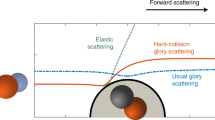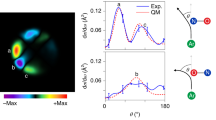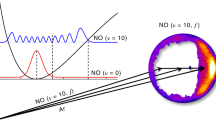Abstract
Stereodynamic descriptions of molecular collisions concern the angular correlations that exist between vector properties of the motion of the participating species, including their velocities and rotational angular momenta. Measurements of vector correlations provide a unique view of the forces acting during collisions, and are a stringent test of electronic-structure calculations of molecular interactions. Here, we present direct measurement of the four-vector correlation between initial and final relative velocities and rotational angular momenta in a molecular collision. This property, which quantifies the extent to which a molecule retains a memory of its initial sense of rotation, or handedness, as a function of scattering angle, yields insight into the dynamics of a molecular collision. We report non-intuitive changes in the handedness for specific states and scattering angles, reproduced by classical and quantum scattering calculations. Comparison to calculations on different ab initio potential energy surfaces demonstrates this measurement’s exquisite sensitivity to the underlying intermolecular forces.
This is a preview of subscription content, access via your institution
Access options
Access Nature and 54 other Nature Portfolio journals
Get Nature+, our best-value online-access subscription
$29.99 / 30 days
cancel any time
Subscribe to this journal
Receive 12 print issues and online access
$259.00 per year
only $21.58 per issue
Buy this article
- Purchase on Springer Link
- Instant access to full article PDF
Prices may be subject to local taxes which are calculated during checkout




Similar content being viewed by others
References
Wayne, R. P. Chemistry of Atmospheres 3rd edn (Oxford Univ. Press, Oxford, 2000).
Roueff, E. & Lique, F. Molecular excitation in the interstellar medium: recent advances in collisional, radiative, and chemical processes. Chem. Rev. 113, 8906–8938 (2013).
Najm, H. N., Paul, P. H., Mueller, C. J. & Wyckoff, P. S. On the adequacy of certain experimental observables as measurements of flame burning rate. Combust. Flame 113, 312–332 (1998).
Bishwakarma, C. K. et al. State-to-state inelastic scattering of O2 with helium. J. Phys. Chem. A 120, 868–874 (2016).
Brouard, M. et al. The fully quantum state-resolved inelastic scattering of NO(X) plus Ne: experiment and theory. Mol. Phys. 111, 1759–1771 (2013).
de Jongh, T. et al. Imaging diffraction oscillations for inelastic collisions of NO radicals with He and D2. J. Chem. Phys. 147, 013918 (2017).
Sharples, T. R., Luxford, T. F. M., Townsend, D., McKendrick, K. G. & Costen, M. L. Rotationally inelastic scattering of NO(A 2Σ+) + Ar: differential cross sections and rotational angular momentum polarization. J. Chem. Phys. 143, 204301 (2015).
McGurk, S. J., Halpern, J. B., McKendrick, K. G. & Costen, M. L. Parity-dependent rotational energy transfer in CN(A 2Π, ν = 4, j F1ε) + N2, O2, and CO2 collisions. J. Phys. Chem. A 118, 2007–2017 (2014).
Paterson, G., Costen, M. L. & McKendrick, K. G. Collisional depolarisation of rotational angular momentum: influence of the potential energy surface on the collision dynamics? Int. Rev. Phys. Chem. 31, 69–109 (2012).
Paterson, G., Costen, M. L. & McKendrick, K. G. Collisional depolarization of rotational angular momentum: what are the observables and how can they be measured? Mol. Phys. 109, 2565–2585 (2011).
Chadwick, H. et al. The collisional depolarization of OH(A 2Σ+) and NO(A 2Σ+) with Kr. J. Chem. Phys. 140, 054306 (2014).
Brouard, M. et al. Rotational alignment effects in NO(X) plus Ar inelastic collisions: an experimental study. J. Chem. Phys. 138, 014310 (2013).
Brouard, M. et al. Rotational orientation effects in NO(X) plus Ar inelastic collisions. J. Phys. Chem. A 119, 12404–12416 (2015).
Lorenz, K. et al. Direct measurement of the preferred sense of NO rotation after collision with argon. Science 293, 2063–2066 (2001).
Luxford, T. F. M., Sharples, T. R., McKendrick, K. G. & Costen, M. L. Experimental testing of ab initio potential energy surfaces: stereodynamics of NO(A 2Σ+) + Ne inelastic scattering at multiple collision energies. J. Chem. Phys. 145, 174304 (2016).
Luxford, T. F. M., Sharples, T. R., Townsend, D., McKendrick, K. G. & Costen, M. L. Comparative stereodynamics in molecule–atom and molecule–molecule rotational energy transfer: NO(A 2Σ+) + He and D2. J. Chem. Phys. 145, 084312 (2016).
Nichols, B. et al. Steric effects and quantum interference in the inelastic scattering of NO(X) plus Ar. Chem. Sci. 6, 2202–2210 (2015).
Brouard, M. et al. Stereodynamics in NO(X) plus Ar inelastic collisions. J. Chem. Phys. 144, 224301 (2016).
Herschbach, D. R. Nobel Lecture: Molecular Dynamics of Elementary Chemical Reactions. Nobelprize.org http://www.nobelprize.org/nobel_prizes/chemistry/laureates/1986/herschbach-lecture.html (2018).
Balint-Kurti, G. G. & Vasyutinskii, O. S. Vector correlation analysis for inelastic and reactive collisions between partners possessing spin and orbital angular momentum. J. Phys. Chem. A 113, 14281–14290 (2009).
de Miranda, M. P. & Clary, D. C. Quantum dynamical stereochemistry of atom–diatom reactions. J. Chem. Phys. 106, 4509–4521 (1997).
Collins, T. L. D., McCaffery, A. J. & Wynn, M. J. 2-Color sub-Doppler circular-dichroism—a 4-vector correlation molecular-dynamics experiment. Phys. Rev. Lett. 66, 137–140 (1991).
Collins, T. L. D., McCaffery, A. J. & Wynn, M. J. 2-Color sub-Doppler circular-dichroism—a 4-vector correlation molecular-dynamics experiment for inelastic and reactive collisions. Faraday Discuss. 91, 91–96 (1991).
Perreault, W. E., Mukherjee, N. & Zare, R. N. Quantum control of molecular collisions at 1 kelvin. Science 358, 356–359 (2017).
Onvlee, J. et al. Imaging quantum stereodynamics through Fraunhofer scattering of NO radicals with rare-gas atoms. Nat. Chem. 9, 226–233 (2017).
Eppink, A. T. J. B. & Parker, D. H. Velocity map imaging of ions and electrons using electrostatic lenses: application in photoelectron and photofragment ion imaging of molecular oxygen. Rev. Sci. Instrum. 68, 3477–3484 (1997).
Khare, V., Kouri, D. J. & Hoffman, D. K. On Jz-preserving propensities in molecular-collisions. 1. Quantal coupled states and classical impulsive approximations. J. Chem. Phys. 74, 2275–2286 (1981).
Khare, V., Kouri, D. J. & Hoffman, D. K. On a Jz-preserving propensity in molecular-collisions. 2. Close-coupling study of state-to-state differential cross-sections. J. Chem. Phys. 76, 4493–4501 (1982).
Chandler, D. W. & Farrow, R. L. Measurement of rotational energy-transfer rates for HD (v = 1) in collisions with thermal HD. J. Chem. Phys. 85, 810–816 (1986).
McCaffery, A. J., Proctor, M. J. & Whitaker, B. J. Rotational energy-transfer—polarization and scaling. Annu. Rev. Phys. Chem. 37, 223–244 (1986).
Sitz, G. O. & Farrow, R. L. Preparation and decay of alignment in N2 (v = 1). J. Chem. Phys. 101, 4682–4687 (1994).
Zare, R. N. Angular Momentum: Understanding Spatial Aspects in Chemistry and Physics (Wiley, New York, 1988).
Fano, U. & Macek, J. H. Impact excitation and polarization of emitted light. Rev. Mod. Phys. 45, 553–573 (1973).
Orr-Ewing, A. J. & Zare, R. N. Orientation and alignment of reaction-products. Annu. Rev. Phys. Chem. 45, 315–366 (1994).
Alexander, M. H., Manolopoulos, D. E., Werner, H.-J. & Follmeg, B. Hibridon; http://www2.chem.umd.edu/groups/alexander/hibridon/hib43/hibhelp.html
Pajon-Suarez, P., Rojas-Lorenzo, G., Rubayo-Soneira, J. & Hernandez-Lamoneda, R. The intermolecular potential of NO(A 2Σ+)-Ne: an ab initio study. Chem. Phys. Lett. 421, 389–394 (2006).
Cybulski, H. & Fernandez, B. Ab initio ground- and excited-state intermolecular potential energy surfaces for the NO–Ne and NO–Ar van der Waals complexes. J. Phys. Chem. A 116, 7319–7328 (2012).
Norman, J. B. & Field, R. W. Collision-induced angular-momentum reorientation and rotational energy-transfer in CaF(A 2Π1/2)–Ar thermal collisions. J. Chem. Phys. 92, 76–89 (1990).
Brouard, M., Hornung, B. & Aoiz, F. J. Origin of collision-induced molecular orientation. Phys. Rev. Lett. 111, 183202 (2013).
Dong, W. R., Mukherjee, N. & Zare, R. N. Optical preparation of H2 rovibrational levels with almost complete population transfer. J. Chem. Phys. 139, 074204 (2013).
Mukherjee, N., Dong, W. R. & Zare, R. N. Coherent superposition of M-states in a single rovibrational level of H2 by Stark-induced adiabatic Raman passage. J. Chem. Phys. 140, 074201 (2014).
Aoiz, F. J., Verdasco, J. E., Herrero, V. J., Saez-Rabanos, V. & Alexander, M. A. Attractive and repulsive interactions in the inelastic scattering of NO by Ar: a comparison between classical trajectory and close-coupling quantum mechanical results. J. Chem. Phys. 119, 5860–5866 (2003).
de Miranda, M. P., Aoiz, F. J., Banares, L. & Saez-Rabanos, V. A unified quantal and classical description of the stereodynamics of elementary chemical reactions: state-resolved k-k'-j' vector correlation for the H.D2(v = 0, j = 0) reaction. J. Chem. Phys. 111, 5368–5383 (1999).
de Miranda, M. P. & Aoiz, F. J. Interpretation of quantum and classical angular momentum polarization moments. Phys. Rev. Lett. 93, 083201 (2004).
Brouard, M. & Vallance, C. (eds) Tutorials in Molecular Reaction Dynamics (Royal Society of Chemistry, Cambridge, 2010).
Aldegunde, J. et al. How reactants polarization can be used to change and unravel chemical reactivity. J. Phys. Chem. A 109, 6200–6217 (2005).
Aoiz, F. J., Brouard, M., Eyles, C. J., Klos, J. & de Miranda, M. P. The collisional depolarization of (2S+1)Σ radicals by closed shell atoms: theory and application to OH(A 2Σ+)+Ar. J. Chem. Phys. 130, 044305 (2009).
Brouard, M., Chadwick, H., Eyles, C. J., Aoiz, F. J. & Klos, J. The k–j–j′ vector correlation in inelastic and reactive scattering. J. Chem. Phys. 135, 084305 (2011).
Acknowledgements
This work was supported by the UK EPSRC via grants EP/J017973/01 and EP/P001459/1. J.G.L. thanks the EPSRC for provision of a DTP studentship (EP/N509474/1). T.F.M.L. acknowledges Heriot-Watt University for a James Watt PhD scholarship. P.G.J. and F.J.A. acknowledge funding by the Spanish Ministry of Science and Innovation (grant MINECO/FEDER-CTQ2015-65033-P) and E. Verdasco for support with calculations. P.G.J. acknowledges funding by Fundación Salamanca City of Culture and Knowledge. The work of D.W.C. was supported by the US Department of Energy, Office of Basic Energy Sciences, Division of Chemical Sciences, Geosciences, and Biosciences, under grant 2019 SNL 17014098. Sandia National Laboratories is a multi-mission laboratory managed and operated by National Technology and Engineering Solutions of Sandia, LLC, a wholly owned subsidiary of Honeywell International, Inc., for the US Department of Energy’s National Nuclear Security Administration under contract DE-NA-0003525. The authors also acknowledge the assistance of P.J. Dagdigian, J. Kłos and M.H. Alexander in performing quantum scattering calculations.
Author information
Authors and Affiliations
Contributions
The research project was conceived and supervised by M.L.C. Experiments were carried out by T.R.S., J.G.L., T.F.M.L. and D.W.C. Data analysis was performed by T.R.S. and J.G.L. Quantum scattering calculations were carried out by T.R.S. Quasi-classical trajectory calculations were performed by P.G.J. and F.J.A. Kinematic apse calculations were performed by M.L.C. and T.R.S. The results were interpreted by T.R.S., P.G.J., F.J.A., D.W.C., K.G.M. and M.L.C. The manuscript was written by T.R.S. with contributions from all authors.
Corresponding authors
Ethics declarations
Competing interests
The authors declare no competing interests.
Additional information
Publisher’s note: Springer Nature remains neutral with regard to jurisdictional claims in published maps and institutional affiliations.
Supplementary information
Supplementary Information
Supplementary Experimental Methods, Supplementary Theoretical Methods, Supplementary Analysis, Supplementary Figures 1–7, Supplementary Table 1
Supplementary Video 1
Animated trajectory on the CF PES leading to N' = 5 (θ = 60°) for which a reversal in the handedness of the NO rotation leads to a change in the direction in which the rotational angular momentum points relative to k. The three atoms are shown as spheres (Ar, yellow; N, blue; O, red) while the rotational angular momentum is shown as a grey line.
Supplementary Video 2
Animated trajectory on the CF PES leading to N' = 5 (θ = 60°) for which a small change in the angle between j and j′ leads to a change in the direction in which the rotational angular momentum points relative to k. The three atoms are shown as spheres (Ar: yellow, N: blue, O: red) while the rotational angular momentum is shown as a grey line.
Rights and permissions
About this article
Cite this article
Sharples, T.R., Leng, J.G., Luxford, T.F.M. et al. Non-intuitive rotational reorientation in collisions of NO(A 2Σ+) with Ne from direct measurement of a four-vector correlation. Nature Chem 10, 1148–1153 (2018). https://doi.org/10.1038/s41557-018-0121-9
Received:
Accepted:
Published:
Issue Date:
DOI: https://doi.org/10.1038/s41557-018-0121-9
This article is cited by
-
Stopping molecular rotation using coherent ultra-low-energy magnetic manipulations
Nature Communications (2022)
-
Side-impact collisions of Ar with NO
Nature Chemistry (2019)



